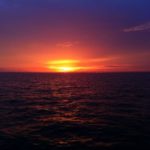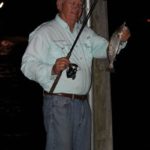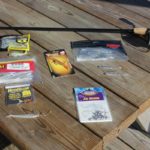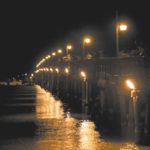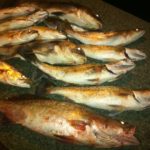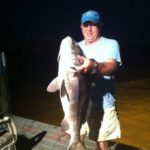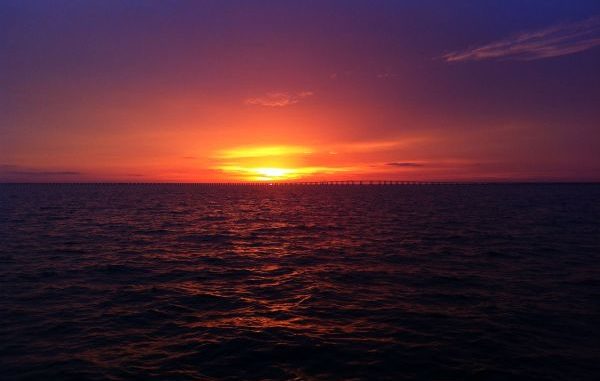
Stay cool when the fishing is hot by heading out after the sun goes down. And all you need for success are a few lights.
As the sun began its lazy descent on the last day of a busy work week, a figure emerged silhouetted against the setting sun. At the end of one arm swung a tackle box, while the other arm clinched two half-crossed fishing poles.
There was a bounce in this man’s step. Even after five hard days at work in the summer heat, he was invigorated as he hurried down the fishing pier.
His destination was a small, wooden platform almost even with the water, where two pilings projected upward. Here were mounted two stadium lights that, with the flick of a switch, would turn the night waters into an illuminated playing field.
The participants would not be ball players but creatures that roam the dark waters to devour and be devoured, both large and small.
The meeting of man and beast would be contested in this arena, under Friday night lights.
There seems to be a mystifying attraction to fishing under lights at night, and many are entranced by it. It presents a new panorama and offers relief from the brutal summer sun.
But there seems to be something more. Perhaps it is the chance to view the marine life attracted to the lights, and to witness a wicked feeding frenzy of predator fish tearing through thick clouds of bait fish and assaulting any offering presented by an angler.
These are moments etched into memories, talked about and rehashed at fish camps as men grow old and boys become men.
To pursue night fishing, elaborate equipment is not needed and having a boat is optional. The fertile salt and brackish waters of the Louisiana coast from Texas to Mississippi have countless light sources where speckled trout, redfish, drum, flounder and many other species gather each night to feed.
Some of these are open to the public for fishing, others are privately owned and many are accessible only by boat.
Night anglers can also bring their own light source and turn any daytime hotspot into an even better spot at night, having it all to themselves.
Here are the ins and outs of this tactic:
Lake Pontchartrain, north shore
Recently, I received a special invitation to fish with one of the most-successful anglers in the area on his private pier on the north shore of Lake Pontchartrain.
Dr. Bob Weiss, aka “Doc,” won the speckled trout division of the STAR tournament in 2012, and he knows how to catch trout.
I got the call at 7:34 p.m. from Doc.
“Steve, I caught a bunch of trout last night, and the lake is calm now. Do you want to give it a try?” he asked.
I couldn’t answer quickly enough.
“I will be there in 10 minutes,” I said.
After a brief tour of his very impressive new home, we made our way down the pier as darkness set in.
“The lake was dead calm 15 minutes ago, now this southwest wind has come up,” I heard Doc mumbling as we walked, “It might make things tough.”
Once we reached the end of the pier, Doc handed me a tiny clear sparkle plastic bait with a 1/8-ounce jig head.
“Tie this on,” he said.
I looked at the little lure with skepticism. Sensing my hesitancy, he assured me.
“Look, all the bait in the lake is small right now,” he said. “You have to match the hatch.”
With that, I began tying on the lure. Before I completed the knot, Doc exclaimed, “There’s one!”
I looked up to see a sliver-sideed speckled trout skipping across the surface of the water, shining in the glow of the lights.
“It looks about 13 inches; that’s the size that I have been catching — between 12 and 15 inches,” Doc said. “Not large, but the best kind to eat.”
I, too, soon got in on the trout action.
As we fished, I asked Doc for some suggestions for the average angler to be successful fishing under lights at night.
“First, you want calm conditions, and you don’t want to fish all the way on the bottom,” he explained. “Instead, you want to suspend the bait. Most of the action is close to the top. I use a light jig head to keep the bait up, and I work the lure using a steady retrieve with a twitch.
“You can really feel it when they hit. If you see baitfish breaking the surface, cast right into that area. The fish seem to hang out more on the edge of the light than right in the light.”
As far as baits, this night Doc was fishing the 1-inch Tsunami swim bait in glow, and I was fishing a 2 ½-inch Fin-S Fish in ice color. Gus’ Tackle in Slidell carries both of these.
But Doc said it can take some experimentation to nail down what the fish want on a given night.
“Try different baits and different presentations until you get a few hits and find out what they want,” he said.
Most of the time, Doc leaves his lights on all night, and will usually try fishing right after dark (before his bedtime of 9:30 p.m.) and again around 4:30 a.m. when he wakes up.
“They can be active anytime during the night,” he said. “I can sometimes hear the trout popping on the surface all the way from my back porch, and I know it is time to get out there.”
We fished for about an hour, and had six keeper trout and two throwbacks. Plenty enough for dinner.
Lake Pontchartrain, south shore
A little farther to the south but still in Lake Pontchartrain, dedicated night anglers can often be found wandering under lights in search of speckled trout. While many people in New Orleans are heading back home after a night of partying, nighttime anglers are just beginning their night out.
Recent reports indicate that some anglers are catching limits of school trout under the new lights at the Bonnabel boat launch. West End Boulevard also has been producing nice stringers.
When the lake is calm and the water is clear, glass minnows, shrimp and other baitfish appear under the lights and the trout are not far behind.
Based on reports, the best baits have been soft plastics on 1/16-ounce or 1/8-ounce jigheads worked close to the surface with a steady retrieve and an occasional twitch.
Grand Isle
Perhaps the quintessential Louisiana pier fishing experience can be found at night on the fishing bridge at Grand Isle.
Built in the 1930s, this bridge has survived many hurricanes and a fire — and what remains of its original construction continues to provide an experience that is uniquely Louisiana.
On summer nights, crowds gather with seafood cookers, barbecue grills, babies in playpens and, of course their fishing poles.
Fishing at times can be off the charts, with water boiling from fish attacking bait as it is channeled under the bridge into the Gulf or Barataria Bay.
Veteran bridge anglers seem to have the same recipe for success: The bridge is often crowded during the summer months, so many bridge veterans choose to fish between 2 a.m. and sunrise.
A moving tide is preferable and it does not seem to matter if it is incoming or outgoing. Most of the trout action (specks and white trout) is close to the surface around the lights.
Small lures worked aggressively are usually the best combination. Bottom fishing for reds, drum, flounder, sheepshead and channel mullet is very productive, and live and natural baits work best.
All of these species will take live shrimp or fresh market shrimp. Drum and reds seem to have a preference for cracked crab (just pull off the shell and split the crab in two before putting it on your hook). Live pogies and finger mullet also will catch a variety of fish.
It is important to have a way to hoist large fish up to the bridge. Many bridge veterans use a large, hooped crab net to lower under fish to raise them onto the bridge.
Also, don’t forget to bring some crab nets and chicken necks, but make sure you release the female crabs with eggs that are common there.
Although not as popular as the bridge, the Grand Isle State Park also has a lighted fishing pier where excellent fishing can be found using the same baits and techniques.
Expand your night-fishing options
Night-fishing options are greatly expanded for those who have boats and the willingness to deal with the dangers of navigating at night.
Chas Champagne, the owner of Dockside Bait & Tackle and Matrix Shad lures, grew up on the water in Eden Isles. As a youngster, his parents would not allow him to venture outside of the canal system of Eden Isles in his small boat.
But he fished day and night, and soon became an expert in the area.
“When I was young, the fishing was so good I could go out at night around the lights in the canals and easily catch 15 trout and five bass pretty much anytime I wanted,” Champagne said. “The fishing is still very good in the canal system, especially in the fall when the white shrimp come in.”
But there’s a lot of great options during the dog days of the year.
“During the summer months, the best night fishing is around all the lighted piers on Carr Drive, Old Rat’s Nest Road (now Lakeview Drive), Treasure Isle, Rigolets Estates and Highway 90,” Champagne said. “If there are any trout in the area, you will definitely find them under the lights at night.”
Champagne said one of the major advantages of using a boat to night fish is that you can select the best area to fish based on wind direction, tides and water clarity. He said you can move around in that general area, from pier to pier, until you locate a good bite.
By the end of the night, you will have a nice box of fish, he said.
Champagne mentioned that anglers fishing lighted piers should be courteous to pier owners and simply choose other piers when the owners are fishing. The waters are open to anyone to fish, but the lights and piers are private property, so be respectful.
When asked about baits, tackle and techniques, Champagne said there is a simple rule.
“For night fishing under lights, you really want to downsize your baits,” he said. “Most of the time the trout will be on top of the water, so you want to use a 1/8- or 1/16-ounce jighead and small soft-plastic baits.
“I simply bite about an inch off the front of a Matrix Shad and thread it on the jighead.”
Champagne also divulged one of his closely guarded secrets.
“If you see glass minnows under the lights and want a rig that imitates them almost exactly, use a split-tail Bass Assassin or a Zoom Fluke and attach it to a hitch-hiker rig, which is a trailer rig that has a cork screw that you screw into the head of the lure,” he explained. “You then attach it to a small kahle hook. This rig allows the lure to swim freely, and this presentation is deadly — it is real finesse fishing.”
Champagne also said VuDu and DOA shrimp work well under lights when shrimp are in the area.
Champagne recommended light spinning rods and reels with 6- to 10-pound-test line to help toss the light baits farther.
He said the best presentation is normally a steady retrieve with a twitch or a stop-and-go retrieve. He mentioned that he has not found cork fishing to be very productive under lights.
Champagne also recommended changing to a 1/4- or 3/8-ounce jighead to work the bottom if you are not seeing activity on the surface.
According to Champagne, the best conditions for night fishing are calm waters and a falling tide.
“I am not sure why,” he said, “but night fishing under lights is always better when it is calm.”
